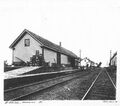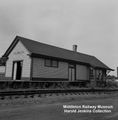Dominion Atlantic Railway Digital Preservation Initiative - Wiki
Use of this site is subject to our Terms & Conditions.
Difference between revisions of "Category:Stations"
Dan Conlin (talk | contribs) (→Gallery: CVR Kentville example) |
Dan Conlin (talk | contribs) |
||
| Line 61: | Line 61: | ||
<Gallery> | <Gallery> | ||
File:WARStation.jpg|2nd Generation [[:Category:Windsor and Annapolis Railway|Windsor & Annapolis Railway]] Station plans, based on the the [[Lawrencetown Station]], drawn by [[:Category:Dan Conlin Collection|Dan Conlin]], 2004. | File:WARStation.jpg|2nd Generation [[:Category:Windsor and Annapolis Railway|Windsor & Annapolis Railway]] Station plans, based on the the [[Lawrencetown Station]], drawn by [[:Category:Dan Conlin Collection|Dan Conlin]], 2004. | ||
| − | + | Image:KentvilleStationb.jpg|The W&A headquarters [[Kentville Station]] with the [[:Category:Subdivision Kingsport|Cornwallis Valley Railway]]'s station in Kentville to the right, circa 1900. | |
File:DAR - Engine 13 Gabriel - Kingsport - Possibly Lee Boles Photo - Unknown Date.JPG|[[DAR0013|Locomotive No. 13 "Gabriel"]] at the [[Kingsport Station]], circa 1895-1911. | File:DAR - Engine 13 Gabriel - Kingsport - Possibly Lee Boles Photo - Unknown Date.JPG|[[DAR0013|Locomotive No. 13 "Gabriel"]] at the [[Kingsport Station]], circa 1895-1911. | ||
File:DAR - Port Williams Station B - Harold Jenkins Photo-1960.jpg|[[Port Williams Station]], a W&A second-generation, long station, passenger end, 1960. | File:DAR - Port Williams Station B - Harold Jenkins Photo-1960.jpg|[[Port Williams Station]], a W&A second-generation, long station, passenger end, 1960. | ||
Revision as of 16:11, 22 January 2025
Dominion Atlantic Railway Stations
Introduction
Links to pages with images and details about individual DAR's stations are found at the end of this article. For an summary list of stations by name see Louis Comeau's Dominion Atlantic Station List by Name.
Design
The DAR had a family of station styles which began with the designs of its predecessor companies the Windsor and Annapolis Railway and the Western Counties Railway. To these were added a variety of standard CPR designs as well as some station styles from branchlines absorbed into the DAR. As telegraph train dispatching declined in the 1960s and traffic to smaller stations dwindled, many smaller stations were abandoned in the 1960s and 70s. A final flourish of station building occurred in the 1980s when passenger traffic revived and VIA rail upgraded stations and shelters for the final years of DAR service.
W&AR Original Wood Stations ~1869
10 Stations were constructed for the original W&AR in 1869. In 1873, the MacNab report[1] indicated there were 23 stations and platform stops. Which stations exactly were of the original 10 are not known at this time but Kentville, Windsor and Annapolis Royal definitely were part of the original 10.
Large Stations
The only large station at the time was Kentville. Kentville was 74' x 32' in size. The station platform was 350' x 12' and on the freight station side the platform measured 260' x 12'. The two storey station housed the general office upstairs.[1]
Gallery
The first recorded photo of the Kentville Station taken in August 1869, also showing the Freight Shed and Car Shop.
Medium Large Stations
Wolfville at 50' x 22' and Bridgetown and Annapolis at 50' x 20' appeared to be a lengthened version of the medium size station. The Waterville station had the same footprint as a medium station at 40' x 22' but had a residence built on the second storey.[1]
Gallery
Wolfville Station platform of wooden station, Wolfville.
The first Annapolis Royal Station station, circa 1880.
Medium Stations
Hantsport, Grand Pre, Port Williams, Waterville, Berwick, Aylesford, Middleton, Lawrencetown and Paradise measured out at 40' x 22' with platforms 150' - 300' long by 11' to 13' in width.[1] From the photos we have, they all appear to be the same design. Interesting that Coldbrook although listed in 1873 as just a platform was in 1949 an original station like the rest in this size. One wonders if a few stations didn't get moved around.
Gallery
Coldbrook Station in August 1949
Paradise Station and warehouse. Date unknown.
Small Stations
There were two medium small stations: Falmouth at 26' x 15' and Horton Landing at 25' x 12'.[1] The smallest stations were located at Avonport at 9' x 12', Cambridge at 18' x 10', Kingston at 18' x 10' and Round Hill at 18' x 10'.[1]
Gallery
W&AR Second Generation Wood Stations ~1880-1900
The Windsor & Annapolis Railway began to replace its small first generation stations in the 1880s with a larger design which had a distinctive gothic window at one end, an operator's bay and a shallow bell curve awning over the platform. The Cornwallis Valley Railway also used this W&AR station plan for all of its stations. The design was found in two sizes, a 60-foot long version for towns and a 50-foot short version for villages. Slight variations in the style of windows and trims existed depending on the contractors who build the design. The stations were often expanded by extending the freight shed.
W&A Long (60-foot) Stations
Intended for larger communities, this design had a larger 20x30' freight room and additional windows for the passenger waiting rooe. Known examples included: Alershot, Canning, Hantsport, Horton Landing, Port Williams, Berwick, Aylesford, Kingsport, Kingston, Auburn, and Lawrencetown.
Gallery
2nd Generation Windsor & Annapolis Railway Station plans, based on the the Lawrencetown Station, drawn by Dan Conlin, 2004.
The W&A headquarters Kentville Station with the Cornwallis Valley Railway's station in Kentville to the right, circa 1900.
Locomotive No. 13 "Gabriel" at the Kingsport Station, circa 1895-1911.
Port Williams Station, a W&A second-generation, long station, passenger end, 1960.
Detail of air photo showing the back of the Port Williams Station, adjacent fruit warehouses, August 1931.
Berwick Station, a W&A second-generation, long station, freight end, Oct. 5, 1910.
Canning Station, west end with DAR Combine No. 31 "Daphne", circa 1910.
Canning Station from the north, July 1958.
Lawrencetown Station, front, and one of its early apple warehouses, c. 1890.
Lawrencetown Station rear, and eastbound train, early 1900s.
The back of the Aldershot Station in postcard with troop train, circa 1912.
W&A Short (50-foot) Stations
These stations had a smaller, 20' x 20' freight room and can be recognized by the freight doors immediately next to the end walls. They also had a shorter awning that ended at the operator's bay. Examples include: Avonport, Centreville, Falmouth, Sheffield Mills, Round Hill, Tupperville and the Wilmot station.
Gallery
A Nova Scotia Museum postcard showing the earlier Round Hill Station looking east, circa 1905.
Avonport Station, a W&A second-generation, short station, passenger end, Nov. 18, 1962.
Centreville Station, a W&A second-generation, short station, freight end, October 1958.
Centreville station, passenger end, winter 1930s.
Falmouth Station, a W&A short station which received a freight shed extension, 1958.
Sheffield Mills Station, from the west, 1958.
No. 17 at the Wilmot Station in Wilmot circa 1900.
WCR Original Wood Stations 1870-1890
The Western County Railway built a series of stations with very wide overhanging eaves and ornate brackets. Smaller stops received simple shelters.
CPR Third Generation Stations 1911 Onwards
After the Canadian Pacific Railway took over the DAR they used a variety of standard CP designs to upgrade small stations or more commonly to replace stations destroyed by fire. They included some with arts and crafts style details such as the Annapolis Royal Station and three in a Tudor revival styles: Digby, Bridgetown and Hantsport.
MRC Original Wood Stations 1898-1905
The Midland Railway designed its own stations which were characterized by a central dormer and ornamental window frames on an otherwise functional exterior. Three sizes are evident, the larger version with the central dormer for towns such as the Brooklyn Station; a smaller one story station for villages such as Clarksville and simple shelters such as Princeport.
Weston Line 1914
The North Mountain Railway, often called the Weston Line, used the a standard CPR branchline station design, Station No. 4 for all of its stations. However they were modified to provide both station function and housing for section crews.
Station Agents
In an era when few women were employed in positions of responsibility business, the DAR had some of the first female station masters in Canada and they ran a number of stations on the line including the Mount Uniacke Station, the Avonport Station, the Grand Pre Station and the Cambridge Station.
References and Footnotes
External Links
*Note to Editors: When creating a new page in this section, open the Template:AAA Station and copy and paste it into the new page.
Pages in category "Stations"
The following 68 pages are in this category, out of 68 total.























